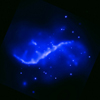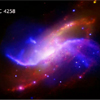Mysterious Arms Revealed

Credit: X-ray: NASA/CXC/Univ. of Maryland/A.S. Wilson et al.; Optical: Pal.Obs. DSS; IR: NASA/JPL-Caltech; VLA: NRAO/AUI/NSF
A combination of space and ground-based observations, including X-ray data from Chandra, has helped reveal the nature of the so-called anomalous arms in the spiral galaxy NGC 4258 (also known as M106). These arms have been known for decades, but their origin remained mysterious to astronomers.
In visible (shown in gold) and infrared (red) light, two prominent arms emanate from the bright nucleus and spiral outward. These arms are dominated by young, bright stars, which light up the gas within the arms. But in radio (purple) and Chandra's X-ray (blue) images, two additional spiral arms are seen.
By analyzing data from XMM-Newton, Spitzer, and Chandra, scientists have confirmed earlier suspicions that the ghostly arms represent regions of gas that are being violently heated by shock waves. Previously, some astronomers had suggested that the anomalous arms are jets of particles being ejected by a supermassive black hole in nucleus of NGC 4258. But radio observations at the Very Large Array later identified another pair of jets originating in the core.
However, the jets do heat the gas in their line of travel, forming an expanding cocoon. Because the jets lie close to M106's disk, the cocoon generates shock waves and heat the gas in the disk to millions of degrees, causing it to radiate brightly in X-rays and other wavelengths.
|
||||||||||||||||||||||||||||||
The image features a dramatic and colorful composite view of the spiral galaxy NGC 4258. The galaxy is predominantly colored in electric blue and purple, with bright red and gold. The galaxy takes the shape of a spiral, with a distinct bright center and unusual “extra†arms extending outwards. The arms appear to twist and curve around each other. A combination of space and ground-based observations, including X-ray data from Chandra, helped reveal the nature of the unusual arms in NGC 4258. These arms have been known for decades, but their origin has remained mysterious to astronomers. In visible (shown in the gold) and infrared (red) light, two prominent arms emanate from the bright nucleus and spiral outward. These arms are dominated by young, bright stars, which light up the gas within the arms. But in radio (purple) and Chandra's X-ray (blue) images, two additional spiral arms are seen.





